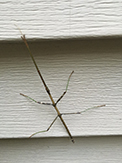Minnesota Walkingsticks

Order Phasmatodea
Phasmatodea (also called Phasmida or Phasmatoptera) is an order of insects commonly known as walkingsticks or stick-bugs. They are characterized by having very long, slim bodies; no wings (except for one species in Florida with very short wings); usually 5-segmented tarsi (end leg segments); 1-segmented cerci (sensory appendages at the end of the abdomen); and usually long and slender antennae. These are plant-feeding insects. They strongly resemble twigs and are very difficult to spot.
More than 3,000 species have been described worldwide. There are 29 species in 10 genera in North America north of Mexico. At least 2 species are found in Minnesota.
Recent Additions

There are more than 3,000 species of walkingsticks worldwide, 29 species in North America north of Mexico, and probably just 2 species in Minnesota. Northern walkingstick (Diapheromera femorata) is the most common walkingstick in North America and in Minnesota. The extremely long, thin, almost cylindrical body strongly resembles a leafless twig making it invisible to predators.
The other walkingstick known to be found in Minnesota, prairie walkingstick (Diapheromera velii), is very similar in appearance. Northern walkingstick is distinguished by its occurrence in forested habitats, the dilated and banded femur on the middle leg of the male, and the much shorter sensory appendages at the end of the abdomen of the female.
In Minnesota, the northern walkingstick population fluctuates on a two-year cycle. The odd numbered years are the “boom” years, the even numbered years the “bust” years. They mate in late summer. The female drops eggs to the ground one at a time. During heavy infestations, female egg-dropping can sound like falling rain. The eggs remain on the ground until the second following spring. After almost two years, they hatch between mid-June late July. During the night, the nymph crawls up the first vertical object it encounters. If that is a stem of a shrub or tree, it begins feeding. Otherwise, it returns to the ground and seeks another vertical object.
Other Recent Additions
This list includes only walkingsticks that have been recorded in Minnesota, but not all of the walkingsticks found in Minnesota.
| Profile | Photo | Video | |||
|---|---|---|---|---|---|
prairie walkingstick (Diapheromera velii) |
|||||
|
|||||
Diapheromera femorata (northern walkingstick)
Diapheromera velii (prairie walkingstick)
No Species Page Yet?
If you do not see a linked page for a species in the list at left you can still upload a photo or video or report a sighting for that species. Click on one of the buttons below and type in the common name and/or scientific name of the species in your photo, video, or sighting. A new page will be created for that species featuring your contribution.
These buttons not working for you?
Simply email us at info@MinnesotaSeasons.com.




